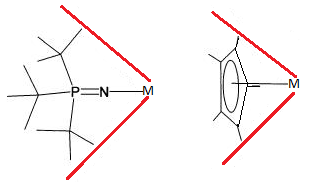Transition Metal Phosphinimide Complexes on:
[Wikipedia]
[Google]
[Amazon]
 Transition metal phosphinimide complexes are metal complexes that contain
Transition metal phosphinimide complexes are metal complexes that contain
 The precatalyst are prepared by
The precatalyst are prepared by
 Transition metal phosphinimide complexes are metal complexes that contain
Transition metal phosphinimide complexes are metal complexes that contain phosphinimide ligands Phosphinimide ligands, also known as phosphorane iminato ligands, are any of a class of organic compounds of the general formula NPR3−. The R groups represent organic substituents or, in rare cases, halides or NR2 groups. NPR3− is isoelectro ...
of the general formula NPR3− (R = organic substituent). Several coordination modes have been observed, including terminal and various bridging geometries. In the terminal bonding mode the M-N=P core is usually linear but some are quite bent. The preferred coordination type varies with the oxidation state
In chemistry, the oxidation state, or oxidation number, is the hypothetical charge of an atom if all of its bonds to different atoms were fully ionic. It describes the degree of oxidation (loss of electrons) of an atom in a chemical compound. C ...
and coligands on the metal and the steric and electronic properties of the R groups on phosphorus. Many transition metal phosphinimide complexes have been well-developed and, more recently, main group phosphinimide complexes have been synthesized.
Complexes of Ti, Zr, V, Ta
Complexes of Phosphinimide are generally prepared by two routes. For highly electrophilic metal chlorides, the silyl derivative is convenient since is generates volatile trimethylsilyl chloride: :R3PNSiMe3 + LnMCl → R3PN-MLn + ClSiMe3 CpTi(NPR3)Cl2 is prepared by this route. More common are salt-elimination reactions: :R3PNLi + LnMCl → R3PN-MLn + LiClPhosphinimide polyethylene catalysts
Phosphinimide ligands have shown promise in the area of ethylene polymerization. In terms of homogeneous catalysts, this field has been dominated by metallocene-based catalysts inspired by the Kaminsky catalyst in 1976. Initially phosphinimide ligands were suggested for polyethylene synthesis due to the fact they have similar steric and electronic properties to metallocene polyethylene catalysts. In most respects the steric and electronic properties, of phosphinimides andcyclopentadienyl Cyclopentadienyl can refer to
*Cyclopentadienyl anion, or cyclopentadienide,
**Cyclopentadienyl ligand
*Cyclopentadienyl radical, •
*Cyclopentadienyl cation,
See also
*Pentadienyl
In organic chemistry, pentadienyl refers to the organic radic ...
are comparable ligands. Metal bound t-Bu3PN− has a cone angle of 87° vs 83 for cylclopentadienyl. Compared to Cp, the bulky substituents of the phosphinimide ligand are more distant from the metal, which increase the exposure of the metal centre to substrate. The less sterically crowded metal centre appears to be particularly susceptible to deactivation however.
 The precatalyst are prepared by
The precatalyst are prepared by alkylation
Alkylation is the transfer of an alkyl group from one molecule to another. The alkyl group may be transferred as an alkyl carbocation, a free radical, a carbanion, or a carbene (or their equivalents). Alkylating agents are reagents for effecting ...
and arylation of the phosphinimide complexes is possible through alkyllithium or Grignard reagent
A Grignard reagent or Grignard compound is a chemical compound with the general formula , where X is a halogen and R is an organic group, normally an alkyl or aryl. Two typical examples are methylmagnesium chloride and phenylmagnesium bromide ...
s, giving products such as CpTi(NPR3)Me2. The zirconium complexes (R3PN)2ZrCl2 can be alkylated or arylated through simple substitution. These organoTi and organoZr complexes are activated by treatment with MAO
Mao Zedong pronounced ; also romanised traditionally as Mao Tse-tung. (26 December 1893 – 9 September 1976), also known as Chairman Mao, was a Chinese communist revolutionary who was the founder of the People's Republic of China (PRC), ...
and B(C6F5)3 as a cocatalyst to activate polymerization through methyl abstraction. The phosphinimide catalyst is thought to be homogeneous
Homogeneity and heterogeneity are concepts often used in the sciences and statistics relating to the uniformity of a substance or organism. A material or image that is homogeneous is uniform in composition or character (i.e. color, shape, siz ...
and single sited. It therefore produces reactivity comparable to metallocene catalysts
A metallocene is a compound typically consisting of two cyclopentadienyl anions (, abbreviated Cp) bound to a metal center (M) in the oxidation state II, with the resulting general formula Closely related to the metallocenes are the metallocene de ...
which are also believed to be homogeneous, single sited catalysts. The catalytic process is assumed to proceed in much of the same way as metallocene based catalysts, as the chemistry is thought to occur primarily with the metal centre and not through the bulky ligands.
References
{{reflist Coordination complexes Transition metals